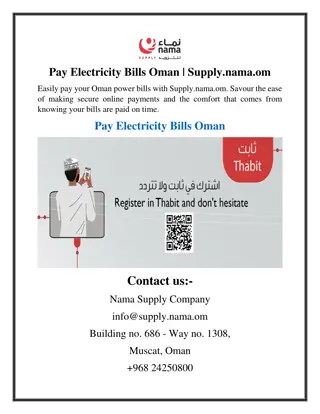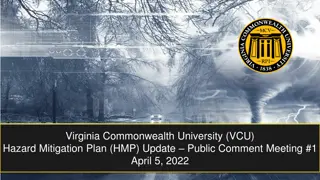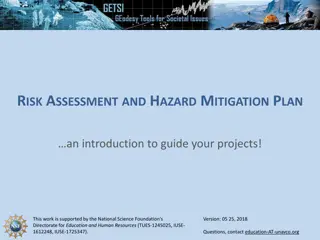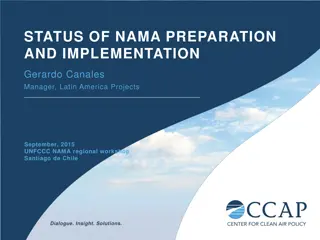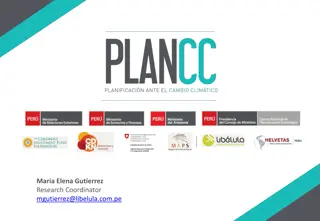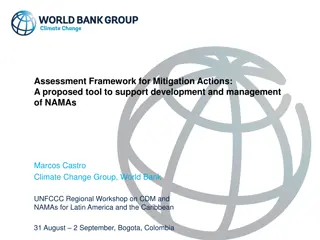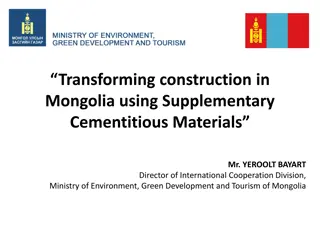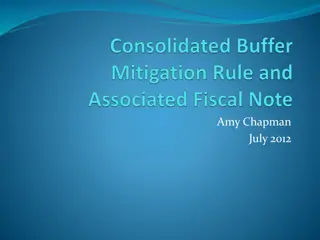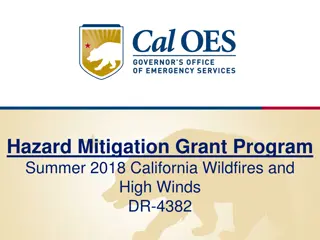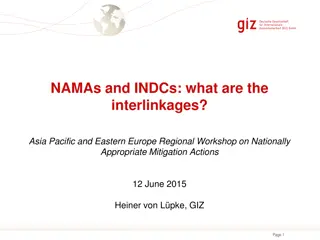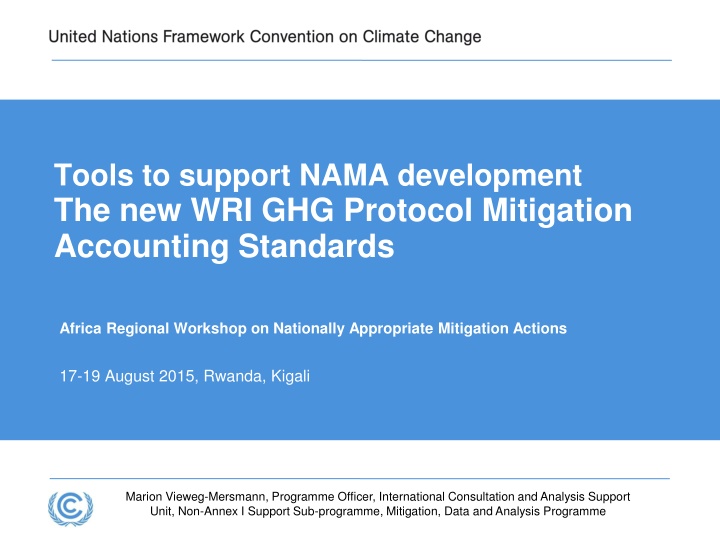
Tools for NAMA Development and Mitigation Actions
Types of mitigation actions and the relationship between different types, along with GHG Protocol standards applicable to NAMAs. Review pilot countries and the purpose of policy and action standards in this comprehensive overview.
Download Presentation

Please find below an Image/Link to download the presentation.
The content on the website is provided AS IS for your information and personal use only. It may not be sold, licensed, or shared on other websites without obtaining consent from the author. If you encounter any issues during the download, it is possible that the publisher has removed the file from their server.
You are allowed to download the files provided on this website for personal or commercial use, subject to the condition that they are used lawfully. All files are the property of their respective owners.
The content on the website is provided AS IS for your information and personal use only. It may not be sold, licensed, or shared on other websites without obtaining consent from the author.
E N D
Presentation Transcript
Tools to support NAMA development The new WRI GHG Protocol Mitigation Accounting Standards Africa Regional Workshop on Nationally Appropriate Mitigation Actions 17-19 August 2015, Rwanda, Kigali Marion Vieweg-Mersmann, Programme Officer, International Consultation and Analysis Support Unit, Non-Annex I Support Sub-programme, Mitigation, Data and Analysis Programme
Types of mitigation actions There are three types of mitigation actions emerging: Goals: Actions that are framed as commitments. They are formulated as economy-wide, sectoral, or technology-related targets. Policies: Actions that aim to impact emissions through relevant national policies. This includes broad strategies as well as the full range of policy instruments, such as regulations, taxes and incentive schemes. Projects: Activities that are targeted at a specific investment or that are limited in scope, scale and duration. This includes the installation of renewable power capacity, infrastructure investments as well as pilot projects and capacity building initiatives. The type of mitigation action will influence the type of information and level of detail provided, especially regarding the steps taken to achieve the action.
Relationship between different types of mitigation actions HIGH LOW ABILITY TO INFLUENCE LARGE-SCALE EFFECTS Goals Strategies Guide LEVEL OF DETAIL Policies & Actions Concretise Projects & Activities Incentivise LOW HIGH LEVEL OF IMPLEMENTATION CONCRETE ASPIRATIONAL
GHG Protocol Standards NEW Relevant for NAMAs Mitigation goal standard HIGH LOW ABILITY TO INFLUENCE LARGE-SCALE EFFECTS Goals NEW Project protocol Policy & action standard Strategies Guide LEVEL OF DETAIL Mainly relevant for INDC process Policies & Actions Concretise Projects & Activities Incentivise LOW HIGH LEVEL OF IMPLEMENTATION CONCRETE ASPIRATIONAL
Pilot countries UK Belgium Germany Japan US Israel China South Korea Tunisia India Mexico Costa Rica Bangladesh Ethiopia Indonesia Colombia Chile South Africa Mitigation goal pilots Policy and action pilots
The policy and action standard - Overview 1. Introduction 2. Objectives Define objectives and define the policy or action 3. Overview 4. Accounting and Reporting Principles 5. Defining the Policy or Action 6. Identifying Effects and Mapping the Causal Chain Identify effects 7. Defining the GHG Assessment Boundary 8. Estimating Baseline Emissions 9. Estimating GHG Effects Ex-Ante Quantify effects 10. Monitoring Performance over Time 11. Estimating GHG Effects Ex-Post 12. Assessing Uncertainty Verify (optional) 13. Verification and report results 14. Reporting
Terminology Ex-ante analysis: The process of estimating expected future GHG effects of mitigation action Ex-post analysis: The process of estimating historical GHG effects of a mitigation action
Chapter 6: Identification of effects Different types of effects can be described, based on the point of view taken: a) By geopolitical boundary: in-jurisdiction/out-of-jurisdiction b) By time frame: short- and long term c) By objectives: intended and unintended d) By probability: likely, possible, and unlikely e) By sign of expected GHG effect: GHG increasing / decreasing Individual effects usually fall into more than one of these categories
Chapter 6: The causal chain concept A causal chain is a conceptual diagram tracing the process by which the policy or action leads to GHG effects through a series of interlinked logical and sequential stages of cause-and-effect relationships. Mapping the causal chain can help identify additional effects not previously identified. It helps to structure and understand cause-effect relationships. Developing and reporting the causal chain is required to be in conformance with the standard.
Example for a causal chain: Home insulation subsidy Reduced emissions from electricity generation Reduced demand for electricity Consumers purchase and install insulation Reduced energy use in homes Reduced emissions from home natural gas use Subsidy for home insulation Increased production of goods & services Increased demand for goods & services Increase in disposable income due to savings Increased emissions Businesses produce more insulation Increased emissions from insulation mfg Key: Policy or action Intermediate effect GHG effect
Chapter 6: Determine significance of effects Based on the assessment of likelihood and magnitude the significance of effects can be determined, following the guidance shown in the table below Magnitude Minor Moderate Major Likelihood Very likely Likely Should be included May be excluded Possible Unlikely Very unlikely May be excluded
Chapter 10: Examples of parameters to be monitored Examples of policies Energy efficiency program in the commercial buildings sector Selected examples of parameters to be monitored Electricity use (annual, direct metering) Emission factor from grid electricity Gross floor area of building units Solar panels produced each year Capacity of solar power installed Electricity generated from solar power Solar power incentives Number of electric vehicles (quarterly) Passenger figures (monthly) Vehicle-kilometers traveled (monthly) Electric vehicle subsidy Emissions trading system Information campaign to encourage energy savings in the residential sector Facility-level monitoring of emissions data from covered facilities Surveys of a representative sample of households to collect data such as: awareness of the campaign, actions taken as a result of the campaign, household size, household income, and household energy use over time
Chapter 14: Reporting Report the results of the assessment according to a standardized set of reporting requirements Five parts to the reporting requirements/template: 1. GHG assessment information 2. Description of the policy or action 3. Estimated change in GHG emissions and removals 4. Methodology 5. Optional reporting information
GHG Protocol Standards and BUR reporting Standards provide useful procedures for estimating impact of mitigation actions (ex-ante and ex-post) which can be used for: Internal decision making at the policy level Reporting on successes to national stakeholders Input to funding proposals for support (e.g. NAMA proposals) Reporting to donors Reporting under the UNFCCC Standards provide useful guidance on reporting of methodologies and assumptions Individual elements can be used as appropriate
Further information The Policy and Action Standard is available in English, French and Spanish Additional matieral available includes: Sample reporting template List of tools and methods Pilot testing summary All material is available at: http://www.ghgprotocol.org/policy-and-action-standard Online training is currently in preparation and scheduled to be finalized later this year
Thank you 17


